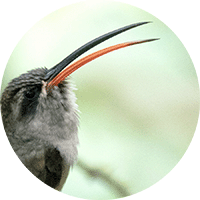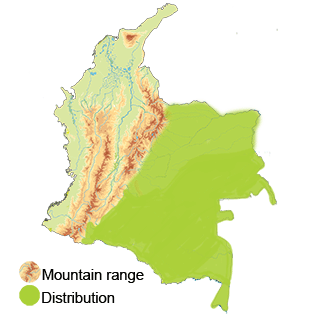White-bearded Hermit
The White-bearded Hermit (Phaethornis hispidus) is a unique hummingbird species. Read in Spanish
Appearance: The White-bearded Hermit is named after the conspicuous white underparts and distinctive white facial markings that give it a "bearded" appearance. It has a generally dark plumage with iridescent green or coppery upperparts. The throat and underparts are white, with the white extending up to the sides of the face.
Habitat: The White-bearded Hermit typically inhabits montane forests, cloud forests, and forest edges in the Andean region of Colombia. It can be found at various elevations, ranging from lower montane forests to high-altitude cloud forests.
Behavior: The White-bearded Hermit is known for its solitary nature and its preference for dense vegetation, where it forages for nectar and small insects. It has a distinctive hovering flight while feeding on nectar from flowers or catching insects in mid-air.
Breeding: Breeding habits of the White-bearded Hermit include courtship displays by males, which often involve aerial acrobatics and vocalizations to attract females. The female constructs a cup-shaped nest made of plant fibers, spider silk, and other materials, typically placed on tree branches.
Conservation Status:
The conservation status of the
Distribution
The White-bearded Hermit (Phaethornis hispidus) is primarily found in the eastern and southern regions of Colombia. These regions include areas within the eastern Andes mountains, the Amazon rainforest, and the Orinoco River basin. The White-bearded Hermit prefers habitats such as humid lowland and montane forests, forest edges, and secondary growth with abundant flowering plants that provide nectar for these hummingbirds. They may also occur in areas with dense vegetation and suitable conditions for foraging and breeding.
Taxonomy
The White-bearded Hermit (Phaethornis hispidus)
- Kingdom: Animalia
- Phylum: Chordata
- Class: Aves (Birds)
- Order: Caprimulgiformes
- Family: Trochilidae
- Genus: Phaethornis
- Species: Phaethornis hispidus
Vocalization
The White-bearded Hermit (Phaethornis hispidus)
- Chirps and Chatters: These high-pitched chirps and chatters are often heard during interactions between individuals, such as courtship displays or territorial disputes.
- Whistles and Trills: The White-bearded Hermit may produce whistling or trilling sounds, especially during aggressive interactions or when defending its territory.
- Buzzing and Humming: Hummingbirds like the White-bearded Hermit also produce buzzing or humming sounds with their wings during flight, which can add to the overall auditory experience when observing these birds.
- Calls and Vocalizations: In addition to sounds produced during flight and interactions, the White-bearded Hermit may have specific calls or vocalizations used for signaling to mates, warning of potential threats, or communicating within their social groups.





